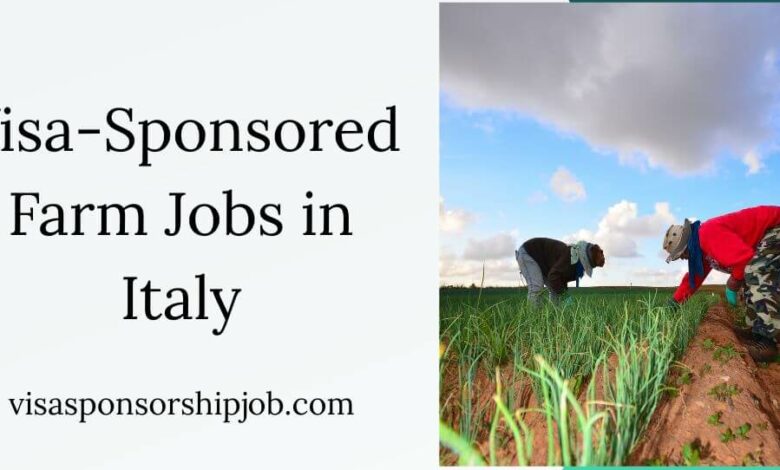Here are the Italian farm jobs that offer residency

Applying for an Italian farm job that comes with residency, especially as a non-EU citizen, primarily falls under the Decreto Flussi (Flows Decree) system. This is the main legal pathway for non-EU citizens to enter Italy for work.
Here’s a breakdown of how it generally works and what you need to know, with a focus on seasonal agricultural work, which often has specific quotas:
1. Understanding the Decreto Flussi
- Annual Quota System: The Italian government annually sets quotas (limits) on the number of non-EU workers who can enter Italy for various types of work, including seasonal and non-seasonal employment. The Decreto Flussi is typically published each year, outlining these quotas and the application periods.
- Employer-Sponsored: For most work visas under the Decreto Flussi, your prospective Italian employer must initiate the application process on your behalf. You cannot directly apply for a work permit yourself from outside Italy.
- Seasonal vs. Non-Seasonal:
- Seasonal Work (Lavoro Stagionale): This is the most common category for farm jobs. Permits are typically valid for up to 9 months within a year. Historically, returning seasonal workers have had priority.
- Non-Seasonal Work (Lavoro Subordinato Non Stagionale): These are for longer-term, year-round employment. Conversion from a seasonal permit to a non-seasonal permit (and thus a more stable path to residency) is possible, and recent changes (May 2025) have made this conversion not subject to quotas, which is a significant positive development.
2. The Application Process (Key Steps for Non-EU Citizens)
Step 1: Employer Applies for “Nulla Osta” (Work Authorization)
- Quota Availability: Your employer must first ensure that the type of job and your nationality fall within the quotas set by the latest Decreto Flussi. Agricultural work usually has a significant portion of the seasonal quota.
- Employer’s Role: Your potential employer in Italy must submit an application for a “Nulla Osta” (work authorization certificate) to the Sportello Unico per l’Immigrazione (SUI), or One-Stop-Shop for Immigration, in the province where the job will take place. This process is increasingly digitalized.
- Labor Market Test: The employer might need to demonstrate that no suitable Italian or EU candidates are available for the position.
- Documentation: The employer will need to provide details about the job offer (contract duration, salary, working conditions), proof of their financial solvency, and sometimes proof of suitable accommodation for you.
Step 2: Nulla Osta is Approved & Sent to Consulate
- If the “Nulla Osta” is approved (this can take a few weeks to several months, though recent changes aim to speed this up), it is electronically transmitted to the Italian Embassy or Consulate in your country of residence.
Step 3: You Apply for a Work Visa (Type D)
- Visa Application: Once the Consulate receives the “Nulla Osta,” you can apply for a long-stay national work visa (Type D) at the Italian Embassy or Consulate in your home country.
- Required Documents (Typical):
- Valid passport (with at least 3 months validity beyond your intended stay)
- Completed visa application form
- Passport-sized photos
- The “Nulla Osta” from your employer
- Proof of accommodation in Italy
- Proof of financial means (though primarily the employer’s responsibility for a work visa)
- Travel health insurance (initially, before you get into the Italian health system)
- Confirmed flight reservation (sometimes required)
- Any other documents requested by the specific Embassy/Consulate.
- Biometrics: You will likely need to provide biometric data (fingerprints and photo) as part of the visa application.
Step 4: Enter Italy and Apply for a Residence Permit
- Arrival: Once your Type D visa is granted, you can enter Italy.
- Residence Permit (Permesso di Soggiorno): Within 8 working days of your arrival in Italy, you must apply for a Permesso di Soggiorno (residence permit) at the local Questura (police headquarters) or through the post office (using a specific kit). This is crucial for legal residence and work in Italy. You will usually sign a “contract of stay” at the SUI as well.
- Start Working: Recent reforms (May 2025) indicate that seasonal workers can start working immediately upon arrival after submitting the Unilav employment form and registering with Italy’s INPS (social security) system, even before the residence permit is finalized. This is a major improvement.
- Integration Agreement: You will likely need to sign an “Accordo di Integrazione” (integration agreement) committing you to learning basic Italian language and civic principles.
3. Pathway to Residency
- Seasonal Permit: A seasonal work permit is typically valid for up to 9 months and is generally renewable for further seasonal work.
- Conversion to Non-Seasonal Permit: This is the key to longer-term residency. If you have worked as a seasonal worker for at least two consecutive years, you can apply to convert your seasonal residence permit into a non-seasonal employment residence permit. As mentioned, recent policy changes have made this conversion process no longer subject to quotas, significantly easing the path to more stable employment and residency.
- Long-Term Residency: After 5 years of continuous legal residence in Italy (holding renewable residence permits), you may be eligible to apply for an EU long-term residence permit (Permesso di Soggiorno UE per soggiornanti di lungo periodo), which grants you a more permanent status.
4. Finding Farm Jobs in Italy
- Employer Initiative: Remember, the employer is the one who initiates the work permit process. So, your primary goal is to find an Italian farm that is willing to hire and sponsor a non-EU worker.
- Specialized Agencies: Some agencies specialize in connecting Italian employers (especially in agriculture) with foreign seasonal workers. Be very cautious and research any agency thoroughly to ensure they are legitimate and reputable.
- Online Job Portals:
- EURES Portal: The European Job Mobility Portal (EURES) can sometimes list seasonal agricultural jobs in Italy. While primarily for EU citizens, it might show demand.
- Italian Job Boards: Look for Italian-specific job search websites (e.g., InfoJobs, Indeed Italy, LinkedIn Italy).
- Agricultural Associations: Italian agricultural associations (like Coldiretti, CIA – Confederazione Italiana Agricoltori, Confagricoltura) may have programs or resources for finding workers.
- Networking: If you have any contacts in Italy (friends, family, or people who have worked there), they might be able to provide leads or even vouch for you.
- Direct Contact: Some brave individuals try to contact farms directly, though this can be challenging without local knowledge or Italian language skills.
- Volunteering/WWOOFing (Important Note!): While volunteering programs like WWOOF (World Wide Opportunities on Organic Farms) exist and can give you farm experience, they DO NOT provide a legal work permit or a path to residency. You cannot use a tourist visa or a volunteer visa to legally work for payment in Italy. These are separate concepts.
Key Challenges & Considerations:
- Quotas: The annual quotas can be limited and fill up quickly, making competition fierce.
- Employer Sponsorship: Finding an employer willing to navigate the bureaucratic process for a non-EU worker is the biggest hurdle.
- Language: While not always strictly required for farm work, basic Italian can greatly improve your chances of finding a job and integrating.
- Bureaucracy: The Italian immigration system can be complex and time-consuming. Patience and thoroughness are essential.
- Cost: There are fees associated with visa applications, residence permits, and sometimes legal assistance.
Recommendation:
Given the complexity, it’s highly advisable to seek guidance from an immigration lawyer specializing in Italian immigration law or a reputable recruitment agency that has experience with the Decreto Flussi and non-EU workers for agricultural sectors. They can provide the most up-to-date information, help you understand your eligibility, and assist your potential employer with the application process.
Disclaimer: I am an AI and cannot provide legal advice. The information provided here is for general guidance only. Immigration laws and procedures can change, so always consult with official sources or qualified legal professionals for the most current and accurate information.
Source: http://thepressradio.com





